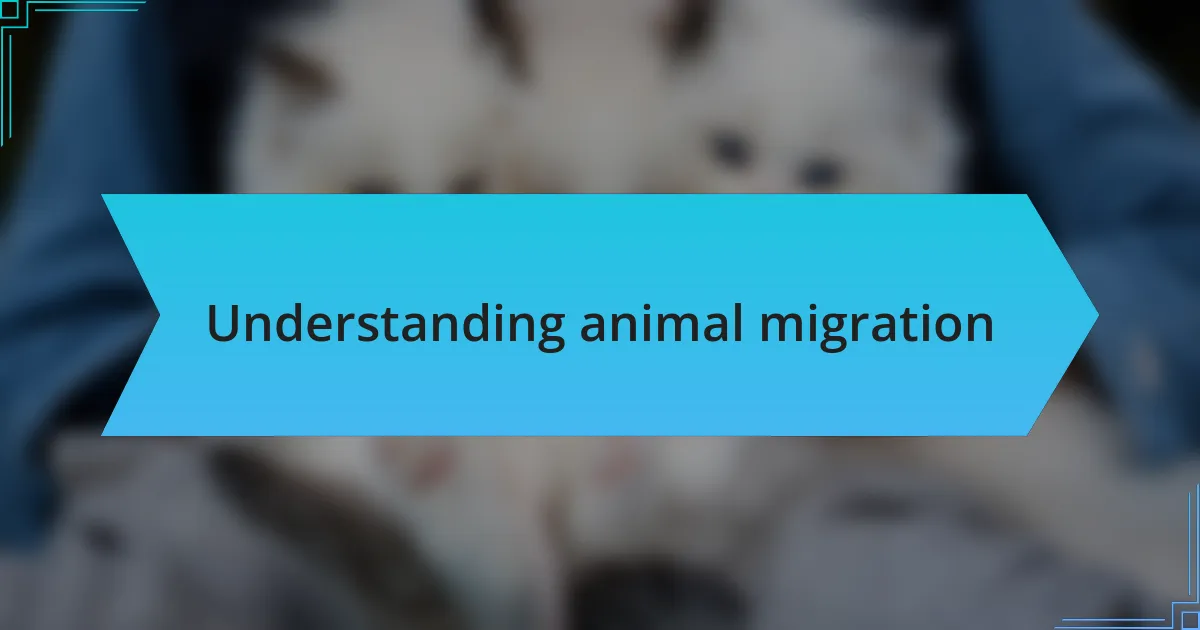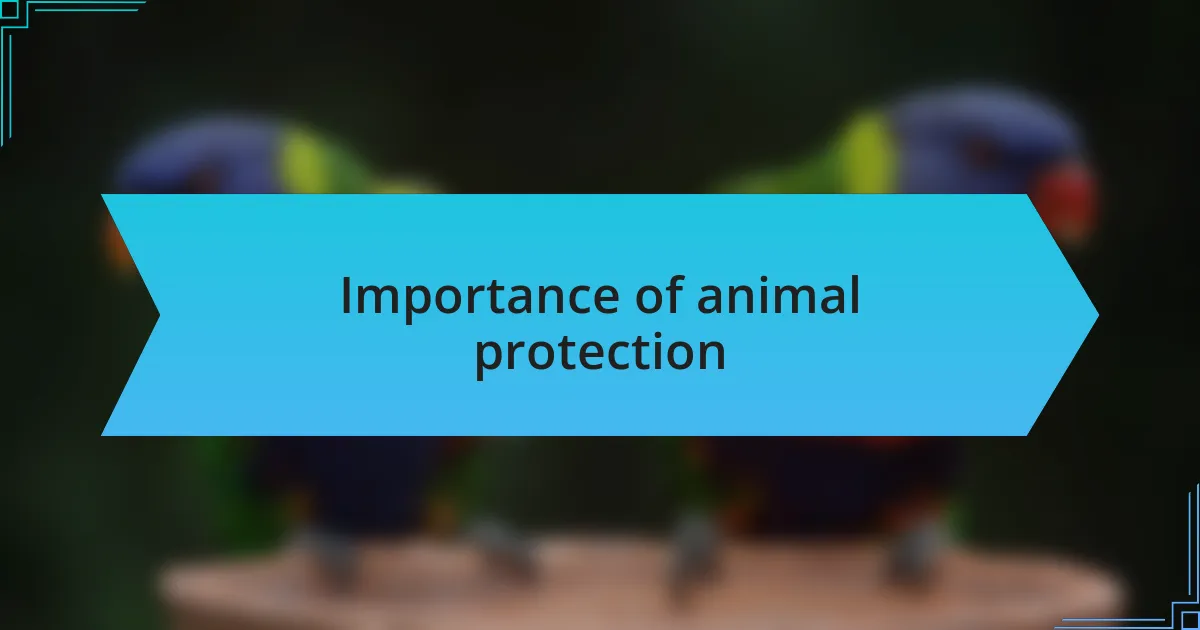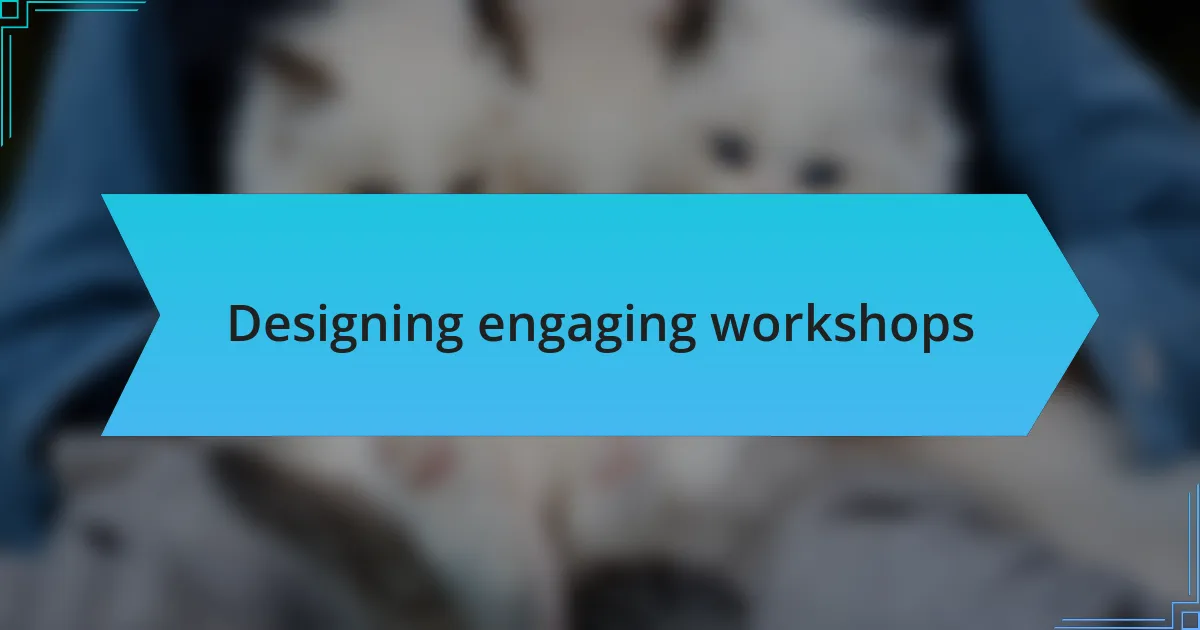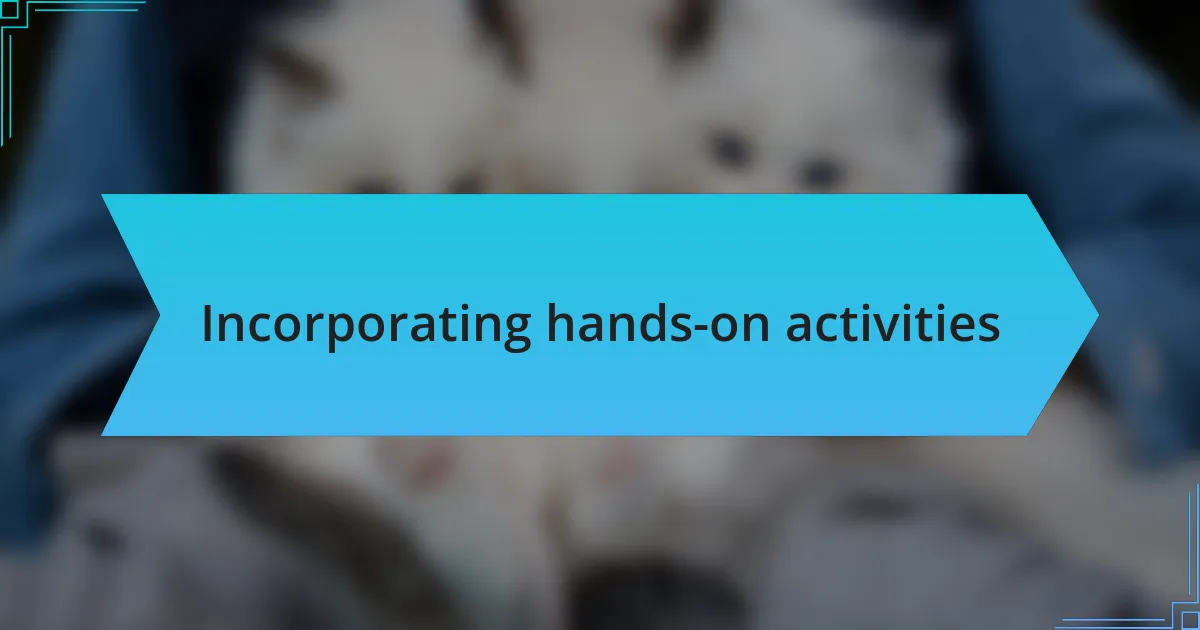Key takeaways:
- Animal migration is driven by instinct and environmental factors, highlighting the necessity for habitat protection amidst changing climates.
- Engaging wildlife protection is crucial for maintaining ecosystem balance and ensuring future generations can experience these natural phenomena.
- Interactive workshop elements, such as simulation games and hands-on activities, enhance understanding and empathy towards migratory species.
- Personal experiences shared during workshops foster emotional connections and a sense of responsibility for wildlife conservation among participants.

Understanding animal migration
Animal migration is the remarkable journey that many species undertake, often driven by the changing seasons, food availability, and reproductive needs. I remember being captivated by the way a flock of geese seemed to choreograph their flight each fall, effortlessly gliding towards warmer climates. How do they know where to go? This instinctual navigation fascinates me, as it hints at a profound connection to their environment that we can only begin to understand.
During my workshops, I often ask participants if they’ve ever seen a monarch butterfly flutter by. It’s astonishing to think that these delicate creatures travel thousands of miles from Canada to Mexico, relying on the same ancient routes year after year. I find it poignant that such small beings can endure such vast distances for survival; it makes me wonder how many challenges await them along the way.
Understanding the patterns of migration opens the door to deeper ecological insights. For example, I once looked into the impact of climate change on these migratory paths, and the stark realities revealed the fragility of these natural processes. It’s a reminder that the survival of migratory species often hinges on our actions, making it crucial for us to protect their habitats and routes. Isn’t it our responsibility to ensure that future generations can witness these incredible migrations?

Importance of animal protection
Animal protection is essential not just for the well-being of individual species, but for the health of our ecosystems as a whole. I recall a moment during one workshop where a young participant shared her love for dolphins. Hearing her passion reminded me of how, without protection, we risk losing not just these intelligent creatures but also the balance they help maintain in marine environments. Isn’t it heart-wrenching to think about what future generations might miss?
Moreover, when I reflect on my own experiences observing wildlife, I often remember the thrill of spotting a bald eagle soaring overhead. It’s a powerful image that embodies resilience and grace. Yet, as we discussed in my sessions, human activities like habitat destruction pose a real threat to these majestic birds. If we fail to protect their environments, we not only jeopardize their survival but also deprive ourselves of the joy they bring to the natural world.
The interconnectedness of life means that protecting animals is inherently tied to our survival. I sometimes wonder, what would happen if we allowed species like bees—vital pollinators—to vanish from our planet? The ripple effect could be catastrophic. That realization pushes me to advocate for animal protection more fervently, knowing that in doing so, we’re safeguarding our own future.

Overview of migration patterns
Migration is a fascinating adaptation that many species use to thrive in changing environments. I remember a moment during a workshop where we traced the incredible journey of the monarch butterfly. Seeing their migration path unfold on a map sparked awe among the participants, as they grasped the distance these small creatures cover—a staggering 3,000 miles from Canada to Mexico. It makes you think, doesn’t it? How can such delicate beings undertake such a perilous journey?
Not all migration patterns are as straightforward. For example, some birds, like the Arctic Tern, travel from the Arctic to Antarctica and back each year—a round trip that can total over 44,000 miles. As I shared this during a session, participants gasped at the sheer scale of their journey. It was a moment of inspiration, one that drove home the point that these migratory routes are essential for survival, influencing food availability and breeding patterns. Isn’t it amazing how instinct drives these animals to such great lengths?
Different species migrate for various reasons, whether it’s for food, breeding, or climate. In one workshop, we discussed how climate change is altering traditional migration patterns, leaving some animals struggling to adapt. I posed a question: How do we reconcile our actions with the impacts they have on these ancient behaviors? It’s a sobering reminder that our role in animal protection is crucial, not only for helping those species but also for preserving the natural rhythms of our planet.

Methods for exploring migrations
Exploring migrations requires a blend of scientific tools and creative storytelling. In my workshops, I often use tracking technology, like GPS collars or satellite tags, to illustrate how scientists monitor animals during their migrations. Watching a real-time demonstration evokes excitement; participants are often amazed at how technology can unravel the mysteries of wildlife movement.
Another effective method involves mapping migrations using historical data and migration routes. In one workshop, we delved into the fascinating history of the wildebeest migration in the Serengeti. By analyzing past records, we could visualize changes over time. I noticed participants’ enthusiasm skyrocketing as they connected the dots between human impact and these natural patterns. It raises a poignant question: How do we ensure these traditions continue in the face of rapid environmental change?
Field trips can be enlightening as well. On one occasion, we visited a local wetland to observe various bird species during their migration period. I encouraged participants to notice the different behaviors and interactions among the birds. It was a tangible, immersive experience that underlined the complexities of migration. It’s moments like these that remind us why we care—each sighting feels like a call to protect these wondrous journeys.

Designing engaging workshops
One key to designing engaging workshops is to incorporate interactive elements that spark curiosity. I once introduced a “migration simulation” game where participants took on the roles of different animals, navigating through obstacles reflective of real-world challenges they face. Watching everyone strategize and collaborate created a palpable sense of investment—it’s fascinating how role-playing can deepen understanding and empathy for these creatures.
In another instance, I used art as a medium to explore migration themes. I set up a space for participants to create their own visual representations of animal journeys. The laughter and shared stories filled the room as we painted, drawing connections between the animals’ travels and our own experiences. Isn’t it remarkable how creativity allows us to express complex ideas in such a tangible way?
Lastly, incorporating multimedia presentations has been a game changer for engagement. I remember one workshop where I used stunning video footage of humpback whales migrating that left everyone in awe. The moment the whales breached the surface, I could see the spark in everyone’s eyes. It highlights the importance of storytelling through visuals—how can you not feel inspired after witnessing the beauty of these great migrations?

Incorporating hands-on activities
To truly make the concept of animal migration resonate, I introduced a unique activity using migration maps. Participants created their own color-coded maps that highlighted different species’ routes. I was amazed at how their faces lit up while drawing the paths. It transformed what could have been a dry lecture into an engaging exploration—who knew that visualizing these journeys could evoke such enthusiasm?
In one workshop, I took things a step further by organizing a scavenger hunt centered around animal migration facts. Each clue led participants to different stations that represented habitats. As they ran from one to the next, excitement bubbled up. I could see how the physical movement mirrored the animals’ journeys they were learning about. Isn’t it fascinating how active participation can deepen one’s understanding?
I also found that incorporating tactile elements made a significant impact. For instance, I gathered various materials like feathers, shells, and stones relating to animals’ environments. I encouraged participants to build their own mini-habitats that reflected migration needs. Watching them manipulate the materials to create something meaningful was both rewarding and enlightening—it sparked conversations about each animal’s specific challenges. How can creating something with your hands not forge a deeper connection to the subject?

Sharing personal experiences and insights
One memorable experience I had during a workshop was when a participant shared a heartfelt story of their childhood birdwatching trips with their grandparents. Hearing them describe the awe they felt while watching migratory birds fill the sky made me realize how personal connections to wildlife can shape our understanding of migration. It’s a reminder that our experiences often intertwine with nature, making the topic more relatable and impactful.
In another session, as I guided a discussion about the challenges animals face during migration, a young participant expressed their concern for species like the monarch butterfly. They shared how they felt empowered to make a difference. This moment resonated deeply with me; it showed how discussions can spark emotional responses and ignite a sense of responsibility toward protecting these fascinating journeys.
I often encourage participants to reflect on their own experiences with wildlife, and I’m continually surprised by the emotional depth of their stories. One participant recalled rescuing an injured bird, describing the bond that formed in those brief hours. It struck me that these personal stories not only enrich our workshops but also create a community of shared values and experiences—all revolving around a love for animal protection. Isn’t it powerful how individual stories can connect us and enhance our commitment to conservation?